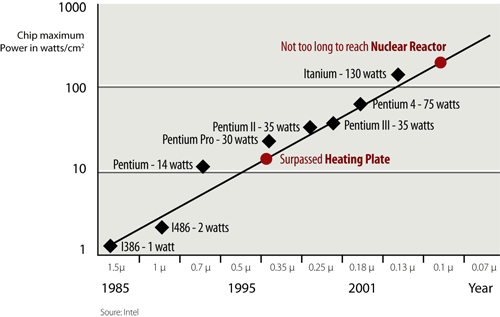The main theme of this issue of CTWatch Quarterly is the new trend within the high performance computing (HPC) toward lower power requirements. Low power computing itself is not new — it has had a long history in embedded systems, where battery life is at a premium. In fact, the applicability of low power has widened its scope in both directions on the power consumption scale. Lower power consumption in the microwatts arena — so-called “ultra low power” (ULP) — is necessary to enable applications such as wireless remote sensing, where a device may have to run on a single small battery for months and need to be networked to collect data. In a more familiar context, most PCs have recently become Energy Star1 compliant. In fact, a really dramatic shift in design emphasis occurred around 2003-2004, when the industry began to move from the pursuit of desktop performance alone to the pursuit of desktop performance/power in combination. Recent processors initially designed for energy efficient notebooks, such as Intel’s Pentium-M, have started to find their way into desktop units. In fact, there is strong speculation that future mainstream PC processors will be successors of the Pentium-M style, a power efficient design.
But why do we want to save power in the HPC arena since the goal has always been to go faster at almost any cost? Certainly it is fair to say that performance/power has always been an engineering concern in designing HPC machines. For example, NEC claims to have achieved five times better performance/power efficiency in their SX-6 model over their previous generation SX-5.2 Where HPC machines function as large servers in datacenters, reducing power would also result in substantial cost savings in their operations. And of course, there are important social and economic reasons for reducing the extremely high power consumption of many HPC installations.
However, the recent attention to low power in HPC systems is not merely driven by such “energy-conscious” requirements alone. There have been recent research results, especially spearheaded by those of the BlueGene/L3 group, that seem to indicate that being low power may be fundamental to future system scalability, including future petascale systems, personalized terascale systems, and beyond. The purpose of the articles in this issue is to reveal such new trends and discuss the future of HPC from the perspective of low power computing.
In the remainder of this article, we will show how low power designs in the traditional arena of embedded computing, plus the very interesting ultra low power systems that are now receiving considerable attention, relate to low power HPC. In particular, we will discuss how technologies developed for low power embedded systems might be applicable to low power HPC and what the future holds for further research and development in this area that aims for greater performance in next generation HPC.







